By Michael Langemeier
Center for Commercial Agriculture
Purdue University
Corn prices and soybean prices were very volatile in 2021. The average corn price in Indiana was $4.32 per bushel in January, increased to $6.32 in June, and will likely be around $5.50 at the end of the year. Average soybean meal prices peaked in January at approximately $440 per ton and will likely be around $350 at the end of the year. Given the uncertainty related to supply and demand, feed prices are likely to remain volatile during the 21/22 marketing year. This article examines trends in feed costs as well as the impact of corn and soybean meal prices on feed costs for farrow-to-finish and swine finishing operations.
It is important to note that the swine finishing enterprise represented in this article assumes the finishing of an early-weaned pig. The rations for the farrow-to-finish and swine finishing enterprises consist of corn, soybean meal, dry distillers’ grain, and supplements. Corn prices represent averages for Indiana as reported by USDA-NASS. Soybean meal and distillers’ grain prices are obtained from Feed Outlook, published monthly by USDA-ERS. Information from Agricultural Prices, a monthly USDA-NASS publication, was used to compute supplement prices. Early December futures prices for corn and soybean meal were used to project feed indices through 2022. Feed cost indices are reported on a closeout month rather than a placement month basis.
Corn and Soybean Meal Prices
Figures 1 and 2 report monthly corn and soybean meal prices from January 2007 to October 2020. Corn price averaged $4.53 per bushel from 2007 to the current month. Soybean meal price averaged $351 per ton from 2007 to the current month. Corn prices are expected to remain above the long-run average during 2022. In contrast, soybean meal prices are expected to be at or below the long-run average during 2022.
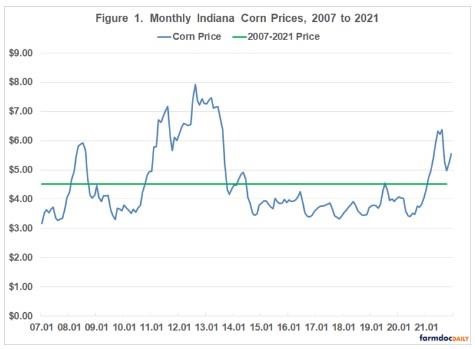
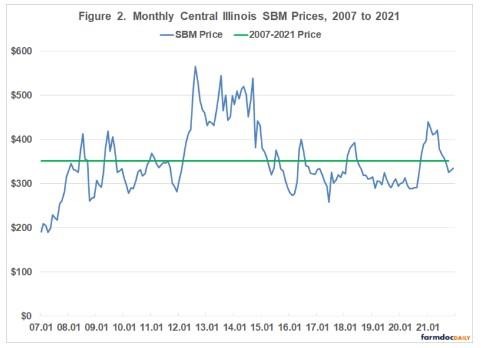
Farrow-to-Finish Enterprise
Figure 3 presents monthly farrow-to-finish feed cost indices from January 2007 to November 2021. The latest full year of indices, 2020, has an index of 100 so all indices outside of this year are expressed in relative terms. The average feed cost index since the beginning of 2007 was 114.0. The index during the last quarter of 2021 is expected to range from 137 to 142, so feed costs during the fourth quarter of 2021 are expected to be approximately 40 percent above average feed costs during 2020. Projected monthly indices for the first 6 months of 2022 are expected to average 132.2 and range from 130.6 in March to 134.4 in January.
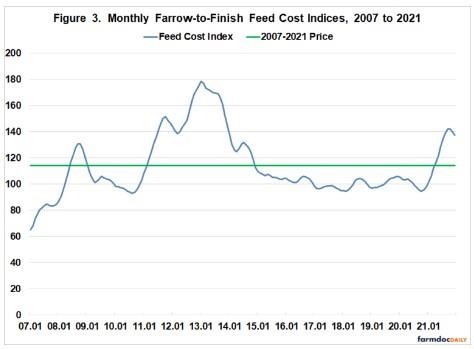
Annual farrow-to-finish feed cost indices are presented in Figure 4. The projection for 2022 used corn and soybean meal futures prices in early December. The projected feed cost index for 2022 is 132.6, which indicates that feed costs in 2022 are expected to be 32.6 percent (4.7 percent) above those experienced in 2020 (2021).
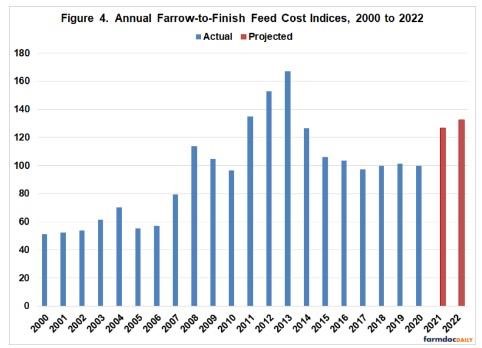
Swine Finishing Enterprise
Figure 5 illustrates monthly swine finishing feed cost indices for the January 2007 to November 2021 period. The latest full year of indices, 2020, has an index of 100 so all indices outside of this year are expressed in relative terms. The average index for the period beginning in 2007 was 112.6. The index for the fourth quarter of 2021 is expected to range from 132 to 139, so current feed costs are substantially above those experienced in 2020. Projected monthly feed cost indices for the first 6 months of 2022 are expected to average 129.4 and range from 127.5 in February to 130.8 in June of 2022.
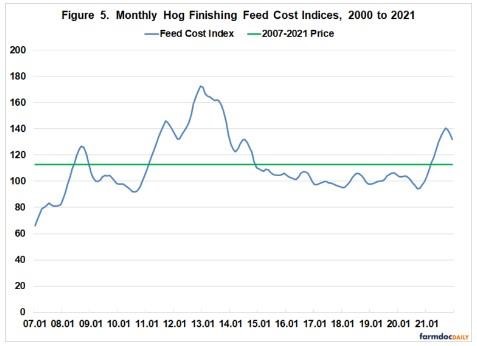
Annual swine finishing feed cost indices are presented in Figure 6. The projection for 2022 used corn and soybean meal futures prices in early December. The projected feed cost index is 129.8, so feed costs in 2022 are expected to be 29.8 percent (2.8 percent) above those experienced in 2020 (2021).
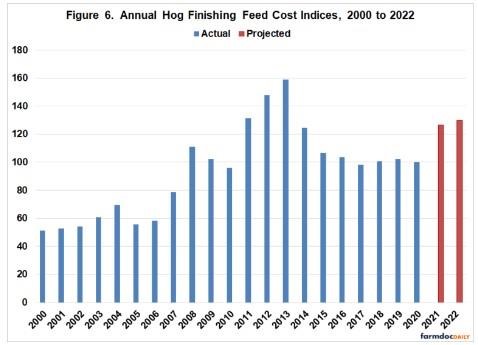
Using the iFarm price distribution tool (here), the probability of the corn futures price for December 2022 being below (above) $4.45 ($6.29) was 25 percent on December 1. This represents a spread of more the $1.80 per bushel. The median expected corn price was $5.29 per bushel. Feed costs are very sensitive to changes in corn and soybean meal prices. Regression analysis was used to examine the relationship between swine finishing feed cost, and corn and soybean meal prices during the January 2007 to December 2020 time period. Results are as follows: each 0.10 increase in corn prices increases feed cost per cwt. by $0.44, and each $10 increase in soybean meal prices increases feed cost per cwt. by $0.32. Obviously, a $0.40 increase or decrease in corn price would have a large impact on feed cost per cwt.
Current feed cost is approximately $41.50 per cwt. Table 1 presents feed cost per cwt. for corn prices ranging from $5.00 to $6.00 per bushel, and soybean meal prices ranging from $300 to $400 per ton. At the lower range of prices, feed cost per cwt. would be approximately $35.70. At the higher range of prices, feed cost per cwt. would be approximately $43.25.

Conclusions
This article discussed recent trends in feed costs for farrow-to-finish and swine finishing enterprises, and provided projections for 2022. Feed costs in 2022 are expected to be approximately 3 to 5 percent above those experienced in 2021. However, current projections have a wide band around them. Current projections use corn prices, depending on the month, ranging from $5.35 to $5.60, and soybean meal prices ranging from $325 to $350 per ton. Corn and soybean prices will be determined by planted acreage as well as other supply and demand factors. Corn prices could be as low as $4.50 to as high as $6.25. This article also examined the impact of changes in corn and soybean meal prices on swine finishing feed cost. Each $0.10 per bushel change in corn price, changes feed cost by $0.44 per cwt. Similarly, each $10 per ton change in soybean meal price, changes feed cost by $0.32 per cwt.
Source : illinois.edu